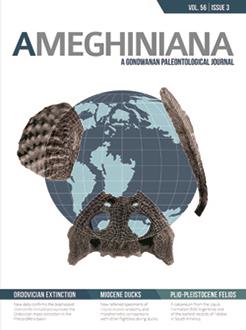Marcos D. Ercoli, Mariano A. Ramírez, Miriam M. Morales, Alicia Álvarez, Adriana M. Candela
Ameghiniana 56 (3), 195-212, (7 April 2019) https://doi.org/10.5710/AMGH.31.03.2019.3206
KEYWORDS: biogeography, Calcaneum, Cenozoic, GABI, Jujuy, South America
The fossil record of the puma lineage in America is sparse, and doubts have been raised about the origin, radiation, and migration events of this lineage. In this study, we present results of comparative and quantitative analyses on a complete left calcaneum, collected by Enrique de Carles at the beginning of the twentieth century. The calcaneum is relatively small-sized, slender-shaped, with a long and lateromedially compressed tubercle, calcaneal canal covered by a bridge that connects the ectal and sustentacular facets, sustentacular facet proximo-medially projected, quadratus plantae process reduced, groove for the flexor digitorum lateralis markedly delimited, and transversely oriented cuboidal facet. Comparative analysis, coupled with principle component analysis using linear measurements, allows us to confidently assign the fossil to the puma lineage. Given the preservation of a single autopodial element and its unique combination of features, we propose assigning the remain to gen. et sp. indet. The morphology of the element suggests cursorial adaptations, intermediate between living South American species and cheetahs. Despite uncertainty regarding exact stratigraphic provenance, the fossil studied represents the first carnivoran known for the Uquía Formation, and one of the earliest records of the puma lineage in America, and of Felidae in South America. These results highlight the already established high value of the Quebrada de Humahuaca for understanding the Great American Biotic Interchange and the need for future prospective campaigns in the region.

